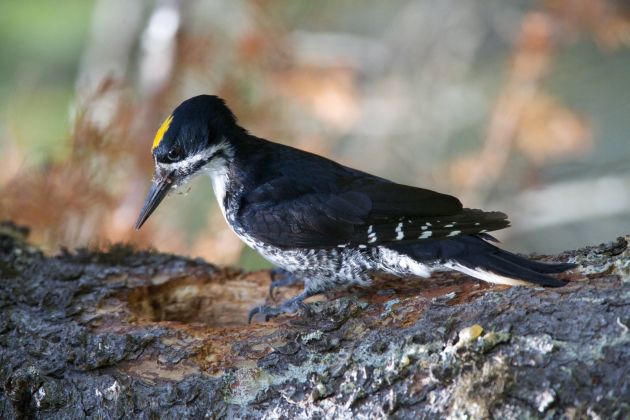
Well, I never did see a Black-backed Woodpecker on my trip, but they were on my mind…
What could be more straightforward than the naming of woodpeckers? The name woodpecker itself is a basic behavioral description. Here are birds that peck at wood. When it comes to individual North American species, the old reliable trick of naming them after physical traits is in full effect. Black-backed. White-headed. Red-cockaded. Ivory-billed. True, in some cases the names are a bit unspecific – Three-toed Woodpeckers aren’t the only woodpeckers with three toes – or technical – “pileated” means “having a crest that covers the pileus”, that is, the head from the bill to the nape – or metaphorical – as in the case of the non-mammalian Hairy Woodpecker. In some cases the physical trait in question is so obscure that it can only be seen in the hand – as in the Red-bellied Woodpecker, prince of causing confusion to feeder watch newbies. In contrast, there are the Flickers, whose characteristic flicking flight can only be seen when they are well out of hand.
The exceptions are still mighty prosaic. Woodpeckers are named after people – Lewis’s Woodpecker – or places – Gila Woodpecker – or things they eat – Acorn Woodpecker, Sapsucker.
If you want anything with a bit of mystique, a bit of dazzle, for the woodpeckers, you have to go to the Latin. Picus was a prince in legend, perhaps a demigod. Ovid tells how he was turned into a woodpecker for refusing to cheat on his wife with the nymph Circe, who you may remember from her later starring role on HBO as someone that you do not want to anger. As a woodpecker, he was associated in Italian myth with the god Mars, with agricultural fertility, and with bird-related divination. From his name is derived the name of the order Piciformes, the family Picidae, and the genus Picoides (as well as the genii Picus and Piculus, which include no North American members).
Still and all, despite such a noble lineage woodpeckers are simple, straightforward, almost relaxing little birds. Their names, if not thrilling, are at least largely unobjectionable.
It’s a shame the same thing can’t be said about things named after them…













I understood that Flickers are so called for their spring contact call; ‘plicka plicka plicka’. That Hairy Woodpecker and Downy are so called as descriptions of the filamentous extension of their back feathers which are long and hairyish in one and downy in the other.
You’re mistaken about the meaning of pileated. The Latin adjective pileatus means “wearing a pileus.” The pileus was an ancient felt cap, often conical in form and coming to a more or less sharp point. The Pileated Woodpecker wears a conspicuous red pileus, hence the name. Other birds with conspicuous caps share the same specific name: e.g., the Capped Heron (Pilherodius pileatus), the Black-capped Piprites (Piprites pileata), the Sooty-capped Bush-Tanager (Sooty-capped Bush-Tanager (Chlorospingus pileatus), and so on.